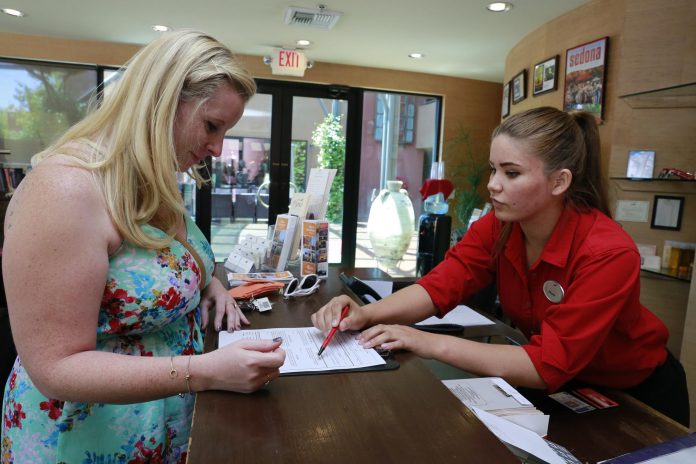Too many jobs, not enough people.
Not exactly a problem you hear from many cities these days. But for Sedona business owners and operators, it’s becoming a serious problem.
With a population of around 10,000 — many of whom are retirees — within the city of Sedona and roughly 28,000 in the Village of Oak Creek, Cottonwood and Camp Verde combined, the available workforce pales in comparison to other areas of the state. Yet, the greater Sedona area draws around 2.8 million visitors, many of whom stay at the nearly 4,000 rooms offered by hotels, timeshares and bed and breakfasts.
A recent Sedona Chamber of Commerce survey asked members to rank the biggest issues facing them as a business in 2016. Nearly 70 ranked “labor supply” as the biggest concern. This did not come as much of a surprise to Chamber President and CEO Jennifer Wesselhoff.
“Affordable housing and workforce has been an issue in Sedona for many, many years,” she said. “However, these extreme survey results indicate that this issue has escalated to a point that warrants deeper discussion and action.”
Workforce supply is directly related to affordable housing, she said. The average cost of a home in Sedona is about $440,000. That’s almost 300 percent higher than the average house in Yavapai County and almost 200 percent more than the average house in Coconino County. In order for a worker to buy a home in Sedona, with 20 percent down, they have to make about $70,000 a year to pay the mortgage.
“That means that most workers, including teachers, guides and other hospitality workers are living outside of the area and commuting to Sedona,” Wesselhoff said. “This is a complex problem that will take years to address and will require multiple partners at the regional and local level. The most important worker is the worker already here. I encourage employers to take care of their employees, train them, give them benefits and pay them well.”
Small businesses need to participate in the conversation and the solution as well — not just the larger employers, she said. Small businesses or businesses with lower paying, less technical jobs are training grounds for the workforce to improve and progress.
“If we all work to keep experienced talent in the pool as people grow and rise through the echelons of local employment, all employers win,” she said. “The chamber sees partnerships, out-of-the-box thinking and broad community commitment to solutions as the key to a future with more qualified employees in the workforce.”
Wesselhoff said that in order to address these big issues, everyone needs to work together.
“We work to connect local businesses to each other because we know no business can stand on its own,” she said. “We strive to get them to find the synergy with other businesses. That will make all our local businesses stronger. We recommend they get as smart as they can about their industry and their audience and that they keep up with modern business practices, because good employees want to work for those kinds of employers.”
An Ongoing Issue
For the Sedona Rouge Hotel & Spa, the issue of filling positions is not a new one, according to general manager Ed Conway. He said it’s been a problem since day one. For them it’s mostly filling housekeeping positions as well as back-of-the-house restaurant staff like dishwashers and bussers. But, because of the higher pay, he said they have little problem filling managerial openings.
Aside from a lack of affordable housing and the high cost of living in Sedona, he said it often comes down to the number of available people to fill dozens — if not hundreds — of job openings throughout the general area.
“There’s just not a lot of people in this market to replace those who go elsewhere,” he said. “In Cottonwood they have big box stores and a vibrant Old Town area so many ask, ‘Why should I drive to Sedona when I can get a job paying the same in Cottonwood?’
“We don’t have the same pool of people to hire from as they do in Phoenix or cities larger than us. Where is this workforce going to come from? I’m not seeing people sitting on the sidelines looking for jobs here.”
Like others, the Rouge has increased its pay, vacation time and benefits to attract and keep people. But sometimes that’s not enough. Conway said they are looking at other potential options such as offering day care for employees but in the meantime they pay sign-on and referral bonuses after 90 days.
“The bottom line is, you have to give people an incentive to walk through your door,” he said.
Lonnie Lillie, general manager of Best Western Plus Arroyo Roble Hotel, said they have a good retention rate among many of their employees who have been with them for years. But it’s a different story when it comes to recent vacancies.
“When we need to hire replacements, that’s a challenge,” he said. “I’ve been running an ad in the Sedona Red Rock News for three months and I’ve had one person apply.”
Like Conway, Lillie offers hiring incentives as well as other perks such as a shuttle van for its maid service, to and from Cottonwood. And while there’s always going to be competition among hoteliers to attract guests, he said attracting employees is often more difficult.
“This is something we’re all dealing with,” he said. “But I don’t recall it ever being this bad. If there is a solution, I don’t know what it is.”
Tina Littleman, director of human resources for L’Auberge de Sedona, Orchards Inn and 89Agave Cantina, said in the 16 years she’s been working here, the available workforce has steadily declined.
“It’s always been a struggle but it’s gotten extremely difficult in the last couple of years,” she said. “The economy is really good right now. We saw similar problems back in 2005 to 2007 when everything was booming. While the demand for more hotels and restaurants here has increased, the workforce has decreased.”
Littleman said they have started bringing in foreign workers under the H-2B program. According to the U.S Department of Labor, the program permits employers to temporarily hire nonimmigrant foreign workers to perform nonagricultural labor or services in this country.
“There is a real wage war here in town, especially when it comes to entry-level positions,” she said. “People are going from one job to another but at the same time there is not an influx of people coming here for work. It’s been my experience that Sedona had a negative unemployment rate — there are more jobs than available workers. That’s why we went the H-2B route, which has been very successful.”
Not Just a Resort Issue
These issues aren’t limited to hotels and resorts — restaurants and retailers are feeling the crunch as well. David Dimler, CFO of the Dahl Restaurant Group, said they have a hard time filling management positions as well as cooks and servers. To try and combat that they offer finder fees and competitive pay rates.
“I think it’s a lack of affordable housing, lack of appropriate skills and poor education,” he said as to cause of the problem.
Sedona Main Street Program Executive Director Holly Epright said members she’s talked to — many of which are ma-and-pa-type businesses — are also having problems filling positions.
“Indeed, restaurants and merchants are struggling greatly with this,” she said. “And it’s not always the lower-paying jobs that are difficult to fill. The comment I’m hearing is that people just can’t afford to live here. And for those who do commute, when you factor in the time and cost of gas and wear and tear on your car, for many it’s just not worth it.”
| Workforce Shortage |
| This is the first of two-part series about workforce and housing issues affecting Verde Valley residents and businesses. The second part of the series will appear in the Wednesday, May 25, edition. |
| Leading the Way |
| Yavapai College is spearheading a Verde Valley workforce committee to address the issue of available workforce and retention of those employees. Its mission is to provide a healthy environment for business development and assist in regional economic development, workforce training and education as a priority element in the 21st century and an essential variable in achieving objectives for business growth. Their scope of work includes the following: Regular review of traditional and real-time labor market information. Labor, wages, employment and job posting analysis. Review and discussion of proven and promising strategies for workforce development in Arizona and the nation. Discussion of current opportunities for training and education. Creation of innovative pathways into work experience. Internships and apprenticeships. In-classroom participation at primary and secondary educational levels for career exploration. Participation in annual job fair. |



